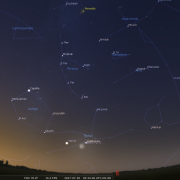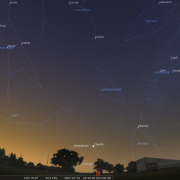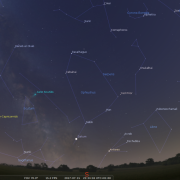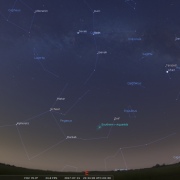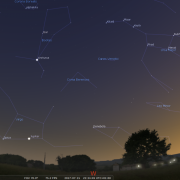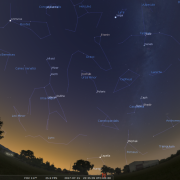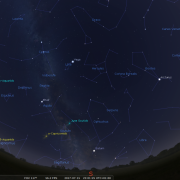In this month's Sky Notes:
Planetary Skylights

 Jupiter continues to dominate the late evening sky across in the SW, but is now sliding down toward the horizon. It resides in the constellation of Virgo not too far above its chief star Spica, which will depart from view in July. Observations of Jupiter are always rewarding, even modest instruments will reveal the dark banding across the disk and the Galilean moons; the configuration of which alters each night. Jupiter’s major storm the; the great red spot is apparent in a larger scope, but only when orientated to us, Jupiter rotates in less than ten hours. The Moon lies nearby Jupiter on the 1st and 28th
Jupiter continues to dominate the late evening sky across in the SW, but is now sliding down toward the horizon. It resides in the constellation of Virgo not too far above its chief star Spica, which will depart from view in July. Observations of Jupiter are always rewarding, even modest instruments will reveal the dark banding across the disk and the Galilean moons; the configuration of which alters each night. Jupiter’s major storm the; the great red spot is apparent in a larger scope, but only when orientated to us, Jupiter rotates in less than ten hours. The Moon lies nearby Jupiter on the 1st and 28th
 Saturn, although not as bright as Jupiter, is nonetheless still conspicuous low to the south, a pearly white “star” of magnitude + 0.1. It resides in the constellation of Ophiuchus –the serpent bearer. A modest telescope will reveal the glorious ring system, which is orientated favourably at present; but you will have to be patient at the eyepiece and wait for those steady seeing moments which will make all the difference to the image. Careful observation will reveal a speck of light close by Saturn; this is Titan, Saturn’s major moon. Our moon lies near Saturn on the 6th.
Saturn, although not as bright as Jupiter, is nonetheless still conspicuous low to the south, a pearly white “star” of magnitude + 0.1. It resides in the constellation of Ophiuchus –the serpent bearer. A modest telescope will reveal the glorious ring system, which is orientated favourably at present; but you will have to be patient at the eyepiece and wait for those steady seeing moments which will make all the difference to the image. Careful observation will reveal a speck of light close by Saturn; this is Titan, Saturn’s major moon. Our moon lies near Saturn on the 6th.
 Venus is now putting on a good show in the dawn sky; around 03:30-04:15h. Look for a brilliant object low to the east. Venus resides in Taurus and will be in conjunction with Aldebaran (the fiery eye of the bull) on the 14th. A waning crescent moon then joins the party on the 20th, making for a pleasing vista.
Venus is now putting on a good show in the dawn sky; around 03:30-04:15h. Look for a brilliant object low to the east. Venus resides in Taurus and will be in conjunction with Aldebaran (the fiery eye of the bull) on the 14th. A waning crescent moon then joins the party on the 20th, making for a pleasing vista.
Meteors & Comets

A number of lesser meteor showers occur during July. The Capri-Cornids have 3 maxima, July 8, 15, and 26, but all have Zenith hourly rates (ZHR) of only half a dozen, the same as sporadic rates. Moon light will interfere with the first two dates.
The Alpha-Cygnids peak on July 21st, again rates are barely more than sporadic levels. Cygnus is well placed high in the SSE by midnight.
The Delta-Aquarids are a little more prolific and peak on July 30th with a ZHR approaching 20. The light conditions outside do however restrict observations to a period between midnight and 03:45h.
Comet 2015 V2 (Johnson) should still be visible in binoculars at mag +7.1 or thereabouts. The comet is passing through Virgo and lies directly above Kappa-Virginis on the 1st.
July 2017 Sky Charts
|
Looking North
Mid-July - 22:35h |
Looking South |
|
Looking East
Mid-July - 22:35h |
Looking West
Mid-July - 22:35h |
| Northern Aspect Mid-July - 22:35h |
Southern Aspect Mid-July - 23:00h |
Additional Image Credits:
- Planets and Comets where not otherwise mentioned: NASA
- Sky Charts: Stellarium Software
- Log in to post comments

